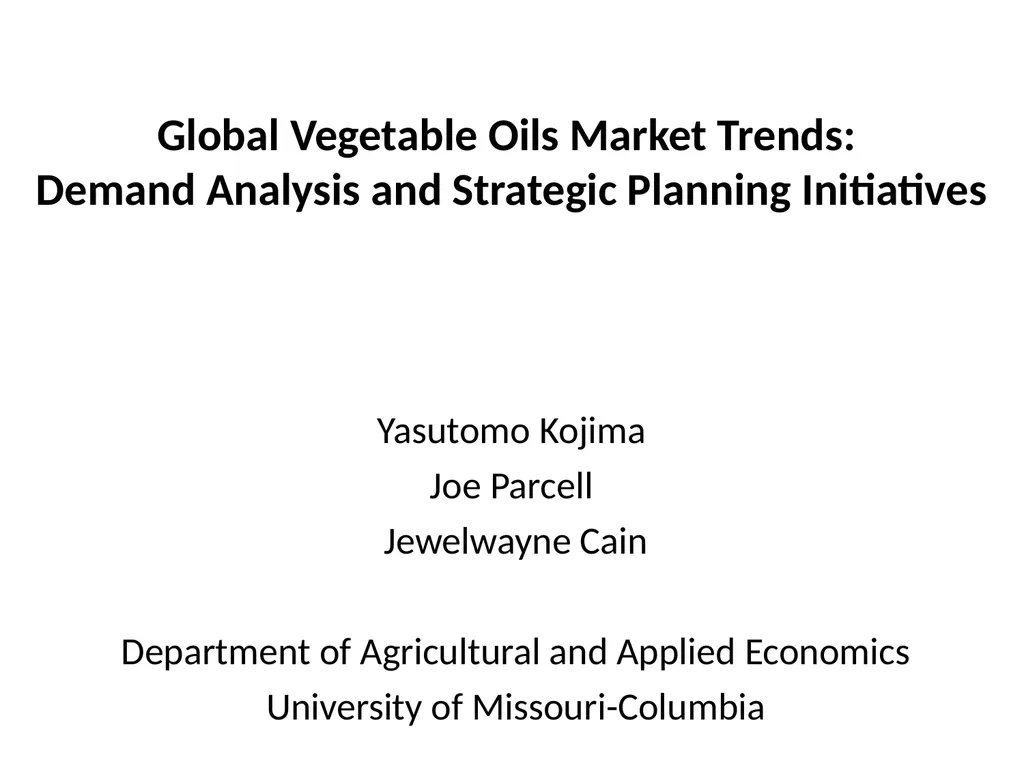Global Vegetable Oils Market Trends: Demand
Author : test | Published Date : 2025-05-24
Description: Global Vegetable Oils Market Trends Demand Analysis and Strategic Planning Initiatives Yasutomo Kojima Joe Parcell Jewelwayne Cain Department of Agricultural and Applied Economics University of MissouriColumbia Introduction Vegetable oils
Presentation Embed Code
Download Presentation
Download
Presentation The PPT/PDF document
"Global Vegetable Oils Market Trends: Demand" is the property of its rightful owner.
Permission is granted to download and print the materials on this website for personal, non-commercial use only,
and to display it on your personal computer provided you do not modify the materials and that you retain all
copyright notices contained in the materials. By downloading content from our website, you accept the terms of
this agreement.
Transcript:Global Vegetable Oils Market Trends: Demand:
Global Vegetable Oils Market Trends: Demand Analysis and Strategic Planning Initiatives Yasutomo Kojima Joe Parcell Jewelwayne Cain Department of Agricultural and Applied Economics University of Missouri-Columbia Introduction Vegetable oils consumption, production and trade have become one of the global topics of interest due to several factors: (i) rising global demand for vegetable oils, especially in emerging economies (ii) health problems related to trans fats (trans fatty acids: TFA) (iii) increasing use of vegetable oils as biofuels feedstock along with crude oil price surge (iv) international concerns over the environmental impacts of palm logging In these circumstances, in order to understand global vegetable oils market trends, it has become essentially important to analyze global demand for vegetable oils from the aspects of food use and industrial use, and to clarify the demand structure of edible and non-edible vegetable oils. The Objective of This Study The objective of this paper is to estimate demand function of vegetable oils for food use and industrial use with cross-country panel data of 156 countries to investigate global demand structure of edible and non-edible vegetable oils to think about strategic planning initiatives Previous Research (1) Empirical analysis of food, biofuel and energy markets. There are mainly three types of approaches, such as 1) Theoretical models (Gardner 2007; de Gorter and Just 2008; de Gorter and Just 2009) 2) Cointegration analyses (Yu et al. 2006; Hameed and Arshad 2008; Peri and Baldi 2010) 3) Partial and general equilibrium (CGE) models (Arnt et al. 2008, Kancs and Wohlgemuch 2008) 4) Theoretical and empirical analysis (Ciaian and Kancs 2011) In order to empirically analyze vegetable oils market based on those theoretical models, we need to estimate demand elasticities of vegetable oils from a global perspective. Currently, the USDA Economic Research Service (ERS) does not provide elasticity estimates of vegetable oils to the public. Previous Research (2) From a regional perspective, Goddard and Glance (1989) analyzed demand relationships among twelve fats and oils in United States, Canada and Japan with data of per capita disappearance from 1962-86. Their study did not include rapeseed oil in the demand equation for the U.S. in their model. And also, they excluded sunflower oil in the model for three countries because some data was unavailable over some or all of the estimation period. We focus on global markets of four vegetable oils: soybean oil, rapeseed oil, palm oil, sunflower oil We estimate own- and














